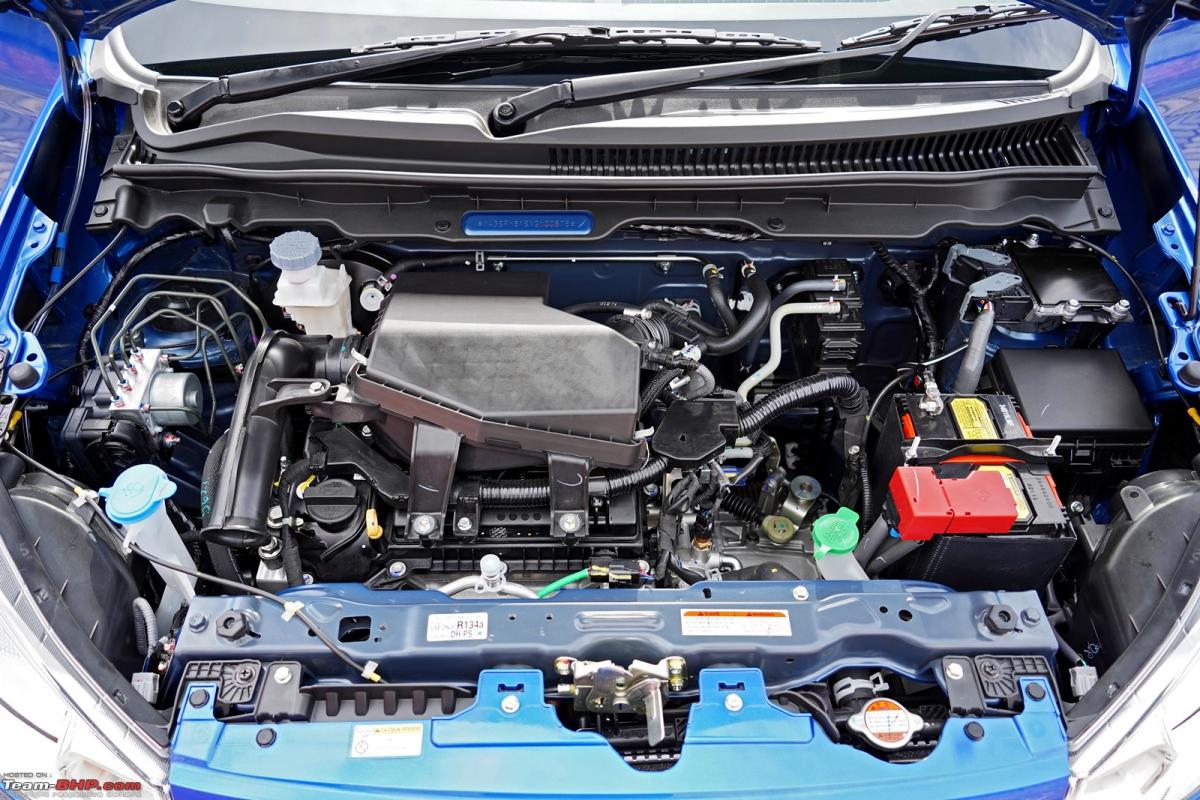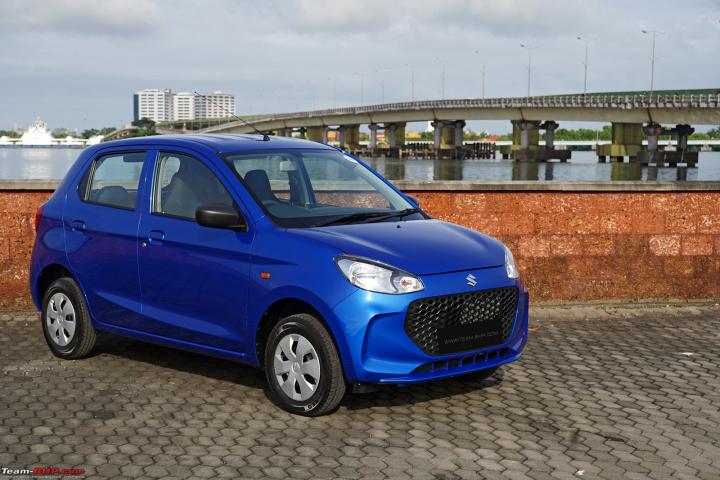News
New Maruti Alto K10 2022: Observations after a day of driving
The motor has adequate pep to keep up with bigger cars on the highway, but the Alto K10 simply isn't planted at speeds above 100 km/h. We strongly recommend owners maintain an extremely safe & conservative driving style over inter-city commutes.
Driving the Alto K10 1.0L Petrol MT
The Alto K10 is powered by the 998 cc, 3-cylinder, 12V DOHC, all-aluminium K10C petrol engine that was introduced in the 2021 Celerio. It churns out 66 BHP @ 5,500 rpm and 89 Nm @ 3,500 rpm. Like the previous versions of the K10, this unit makes the Alto quite peppy and enjoyable to drive. With a kerb weight of merely 716 - 741 kilos, the car has a very healthy power-to-weight ratio of ~90 BHP/ton.

The K10C motor features two notable additions – Dual Jet and Dual VVT. This means that there are two injectors (Dual Jet) per cylinder that spray fuel into the combustion chamber. Having two injectors leads to better atomisation and thereby cleaner combustion. The compression ratio has also gone up from 11 in the K10B to 11.5 in the K10C. VVT or variable valve timing adjusts the valve timing to increase fuel efficiency and in a 'dual' VVT system, both intake and exhaust valves are adjusted to maximise fuel efficiency and performance.
Crank the engine and you immediately realise that this is an entry-level car. Typical of 3-cylinder units, there is a little cabin shake on cranking, while mild vibrations are felt at idle. Release the light clutch and the Alto K10 rolls off from a standstill with ease. It can easily move away from 0 km/h in second gear too with light accelerator inputs. Driveability is excellent and the light kerb weight makes things easy for this little 1.0. The motor feels very tractable in the city and it’s got a practical state of tune. The healthy low-end & perfect gearing means you do not have to downshift too often. Driving around in the city won’t be much of an issue for this small hatchback. In fact, it feels very much at home. The only fly in the ointment is a light, but very perceptible judder felt near idling rpms, especially pronounced in 2nd gear. This was present in the AMT variant as well and is likely to be the result of some aggressive tuning for fuel efficiency.
Out on the open road, the Alto K10's power-to-weight ratio is enough for it to keep up with hatchbacks from a segment above. On the expressway, you'll enjoy redlining this car all the way to 83 km/h in second gear and 120 km/h in 3rd gear. Overtaking is easy & fuss-free. The engine gets vocal at higher revs and not everyone is going to enjoy its audio track. Sadly, the grip levels just can't keep up with the engine and thus, it is best to cruise at speeds of 90-100 km/h in 5th gear.
For quick overtaking manoeuvres, while at cruising speeds, you will have to shift down to 3rd gear as there’s not much progress when you floor the A-pedal in 4th gear. The tall 3rd gear and occasional downshifts to 2nd would take care of your pedal-to-metal driving when on twisty roads.
The clutch is nice and light to operate, with just the right travel length. The 5-speed gearbox could have done with shorter throws. While it is light and slots accurately, it feels a bit rubbery
Noise, Vibration & Harshness (NVH)
The NVH package is cheap & basic. The Alto does alright at city speeds. But as the revs climb, you’ll hear that 3-cylinder thrum that all of us are familiar with since the Maruti 800 days. It is also louder in the Alto than other Marutis with the same engine. Reason = poorer insulation. At 100 km/h, road & wind noise are high. What’s worse, while driving over broken roads, you’ll clearly hear pebbles hitting the inside of the wheel arches (as there is partial / no cladding). Even the sound of rainwater splashing against the wheel wells is heard inside the cabin! Maruti could surely improve the NVH.
Mileage & Fuel Economy
Maruti has done a lot of things to maximise fuel economy. The ARAI-certified fuel economy of the Alto K10 MT is 24.39 km/l. With the AMT gearbox, the fuel economy is even higher at 24.9 km/l. Owners should have no reason to complain in the real world either - we were seeing average MID figures close to 20 km/l despite some heavy foot driving.
That said, the figures are lesser than the Celerio, which debuted with the same motor despite it being a heavier car with much better tyres. We attribute the difference to the idle start-stop system in the Celerio that shuts off the engine while idling, which also adds to the fuel efficiency.
Driving the Alto K10 1.0L Petrol AMT
The 2022 Alto K10 gets the latest generation Magneti Marelli-sourced AMT unit, which is available in the VXi and VXi+ variants.
The AMT mechanism is a simple bolt-on job and uses the K10 MT's existing gearbox. It’s pretty straightforward in the way it works. Mechanically, the AMT gearbox is identical to the K10’s manual transmission. What's different is how the clutch is operated and how the gears are shifted. In the MT, the driver is responsible for these tasks. With the AMT, hydraulic actuators located in the engine bay operate the clutch and shift gears. There's no clutch pedal, and zero driver input is required for gearshifts, making it exactly like a conventional automatic to drive. Simply put, the mechanical functions of operating the clutch and gear lever have moved from inside the cabin to the engine bay. To know more about AMTs & how they work, click here.
Starting the engine must be done with the gear lever in neutral. You have to press the brake pedal as well, or else the engine won't fire up. There's no 'P' (park) mode or gear unlock button like in a conventional AT. Once fired up, slide the gear lever to 'D' (drive) to get going. As you release the brake, the car will move forward without any accelerator input. However, it doesn't move too fast and will crawl at 6-7 km/h, without any accelerator input. When you press the accelerator, you'll notice that the throttle response is quite immediate. It's exactly like a pure manual in this respect.
In the city traffic is where the AMT truly shines and brings the most benefits. There's no clutch pedal and there's no requirement for the driver to repeatedly shift between Neutral-1st-2nd either. In crawling bumper-to-bumper traffic, you don't need to give any accelerator input. Just release the brake, and the car crawls forward. The start-off is extremely smooth. Budget car owners will love the fact that their left leg is completely relaxed. The tricky part with the AMT in city driving though is parking in tight spots. Unlike a conventional AT where it's possible to ease the car forward very gradually, the AMT is more of an "on or off" solution, as it tries its best not to slip the clutch more than required. This results in a more eager movement, which can be a bit tricky when getting in & out of tight parking spaces.
Gear-shifting quality is a universal sore point for automated manual transmissions. The K10's AMT unit, which is the improved version of the previous generation, is actually very good. In fact, it seems like Maruti has finally caught up with Hyundai’s smooth-shifting AMT. With a light foot on the accelerator, the gearshifts are barely noticeable. First-time automatic drivers won't have any complaints with the AMT. It’s only when you are driving with a heavy foot that the shifts are noticeable in the form of the typical head-nod.
People who are used to driving AMT cars will like this unit for sure. One of the ways to make your drive even smoother is to let off the accelerator at intervals, and the AMT will seize that opportunity to upshift. E.g. When going from 0-40 km/h, let off the accelerator very slightly at 10, 20 and 30 km/h, and the AMT will take each one of those opportunities to move up a gear - almost like you told it to! Shift quality gets better between higher gears and is virtually seamless when going downhill. The AMT unit is smooth even while downshifting. There's absolutely no noise or clunking when the gears shift.
Fuel efficiency is without a doubt what the AMT has been tuned for. This means the transmission is very eager to upshift and before you know it, you will be cruising along in 5th gear at 50 km/h. Even in crawling traffic, the AMT will upshift to 2nd gear at fairly low speeds. When the rpms drop, the transmission will downshift to a lower gear. Interestingly, if left without accelerator inputs in rolling traffic conditions - the car will slowly move in 2nd gear at 14 km/h, and the transmission will shift down to first only when the brakes are applied. The current gear indicator on the MID keeps you in the loop as to which gear is engaged. It's quite a novelty and will be appreciated by prospective and existing owners of the Alto K10 AMT.
The engine gives out a nice blip on kick-down and doesn't hesitate to drop down two gears at a time (e.g. 5th to 3rd). With a heavy foot on the accelerator, the AMT holds a gear all the way to the end of the rpm range before upshifting. The driver also has an option to use 'manual mode' to prevent premature upshifts while overtaking on highways.
Manual mode has other advantages as well, especially for the more enthusiastic drivers who want a higher degree of control. Like other hatchbacks with AMTs, the K10 offers a Tiptronic-like manual mode. Towards the right of the MID gear indicator, there is a small alphabet readout: 'M' for Manual & 'D' for Drive, indicating the mode that you are currently in. In manual mode, the AMT will still not upshift automatically unless you reach the end of the rpm range. Conversely, if the rpm drops too low, the AMT will downshift to prevent the motor from stalling. If you try to upshift at too low an rpm or downshift at too high an rpm, the AMT will ignore your instructions and flash the gear indicator in protest. It's always a good idea to switch to manual mode before your favourite ghat section because it prevents sudden & unsettling gear changes mid-corner. An advantage of manual mode is that you can increase the amount of engine braking when going downhill. It's quite effective, although not as aggressive as in a pure MT. We recommend shifting to manual mode before overtaking when you need engine braking and of course, the times that you are in the mood for some fun.
Hill starts require you to use the correct procedure in order to minimize rollback. When starting off on a hill, switching your foot immediately from the brake to accelerator will result in the car rolling back... before it engages the clutch and moves forward. On a steep hill, the car can roll back as much as 3 feet before moving forward. It's dangerous, and also bad for the clutch in terms of wear & tear and overheating. Thus, it's best to use the parking brake when starting off on an incline. This results in only an inch or two of rollback and a very gradual start-off. A "hill-hold" function would have been a neat addition, especially considering the same is already available in the S-Presso.
I'd also like to add that the AMT manages the clutch & gearbox a lot better than sub-par drivers out there. There's no doubt that it is more talented than a below-average driver in choosing when to shift, how to shift and what gear to drive in.
Suspension
Ride Comfort
The Alto K10 comes with a MacPherson strut suspension at the front and a torsion beam with coil springs at the rear. The overall setup feels very basic, with a soft edge to the setup. For an entry-level hatchback, the car remains quite comfortable over rough sections at city speeds. On the highways - smaller patches are absorbed, but not in a confidence-inspiring way - because there is some roll and side-to-side wallow induced when going over the broken stuff. You will feel that the Alto is out of its comfort zone! Larger potholes register themselves sharply in the cabin, and it is possible to bottom out the suspension if you do not slow down. The suspension isn't silent in its operation either, and you can hear it work on a patch of bad road.
Handling & Dynamics
In a nutshell, the car is awesome in the city - its natural habitat. It’s narrow width + tall seating + good low end + peppy engine make it easy to dart in and out of traffic. As expected in such a small car, the turning radius is also small at just 4.5 m.
On the highway, it is mediocre and feels skittish. The motor has adequate pep to keep up with bigger cars on the highway, but the Alto K10 simply isn't planted at speeds above 100 km/h. We strongly recommend owners maintain an extremely safe & conservative driving style over inter-city commutes. Keep it at 100 km/h or below.
Body roll is present and this is not a car you'd like to corner hard in. The car's 13" rims are shod with 145/80 section JK Ultima-Neo tyres. Chosen for fuel-efficiency, these tyres are too thin for fast cornering - even the previous generation car had 155 section tyres! Woefully inadequate for the power on offer, and you have to be very careful while cornering, especially in wet situations.
Steering
The electric power steering in the Alto K10 is one-finger light at parking and city speeds. This makes it a very easy car to drive in urban surroundings. However, some might feel the steering is too light and vague in the center and you get no feedback at all. It’s pretty much dead like a video game steering. The mass market will like it though. At higher speeds, the steering does weigh up, but the complete lack of feel or feedback can be unnerving. Like the steering in most Maruti cars, there is no strong return to center action. Leave the steering at a slight angle while driving and you will keep on going in that direction. You have to manually straighten it.
Braking
The Alto K10 is equipped with disc brakes at the front and drum brakes at the rear. The brakes perform well and as you would expect without any drama. But there is only so much grip that can be provided by 145 section tyres, before ABS kicks in.
Niggles & Problems
The previous generation Alto K10 had quite a few issues with the AMT unit. Hopefully, the newer generation Magneti Marelli AMT unit isn’t riddled with problems. Apart from this, Maruti has a wide service network and part availability is never much of an issue. So ownership experiences should be satisfactory. That being said, get the extended warranty without giving it a second thought.
Continue reading the discussion on the Maruti Alto K10 on our forum.







.jpg)










